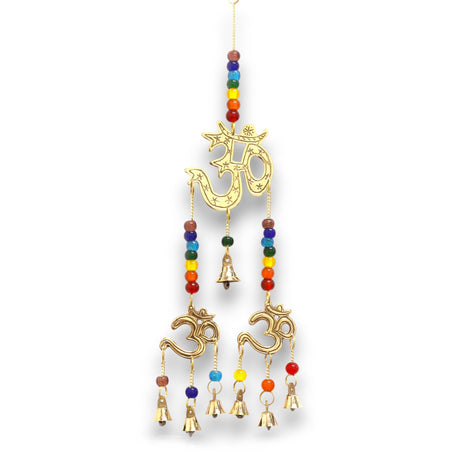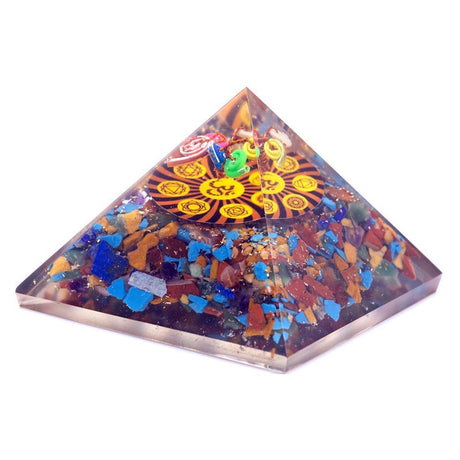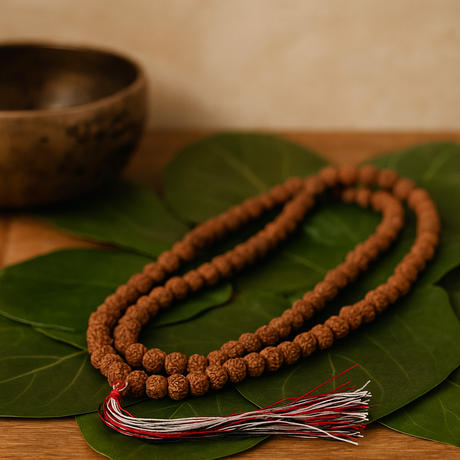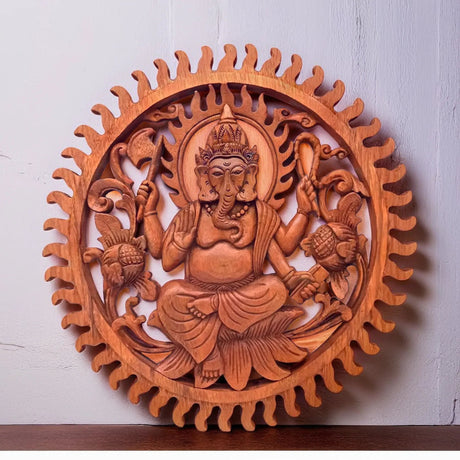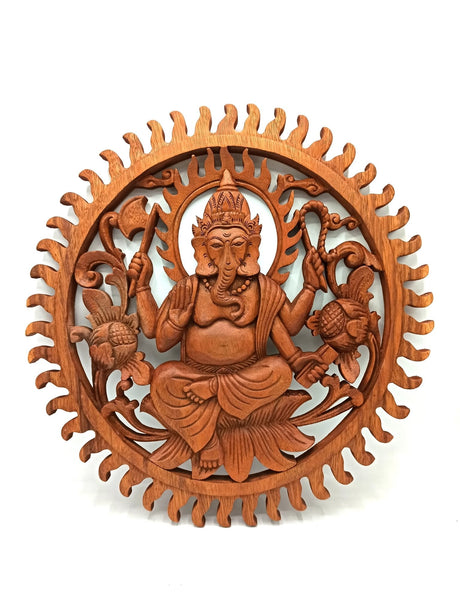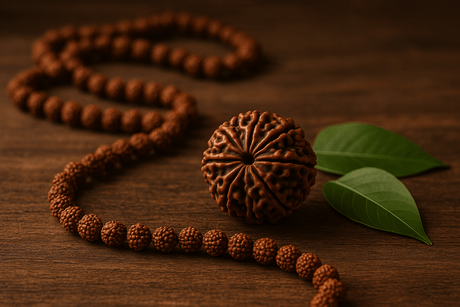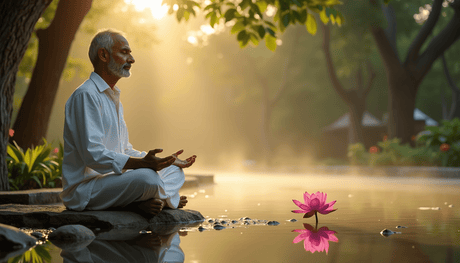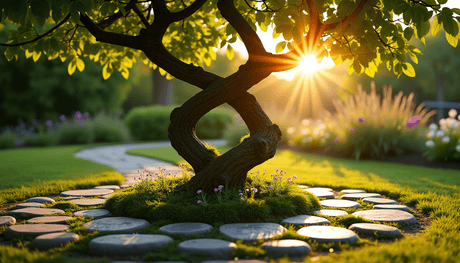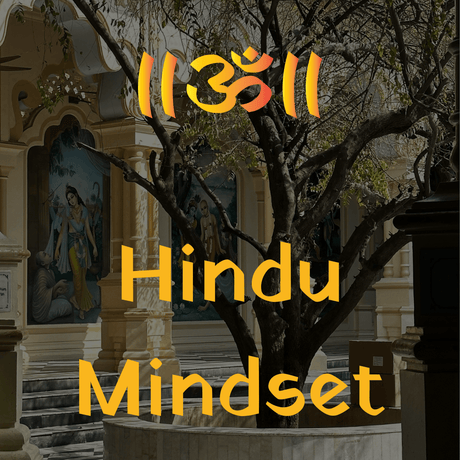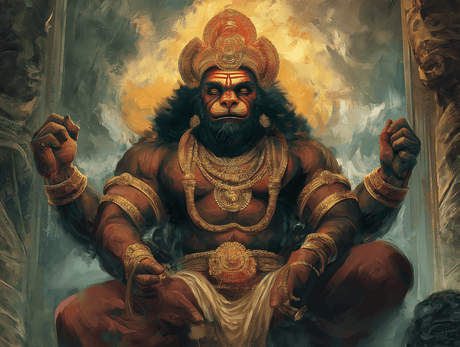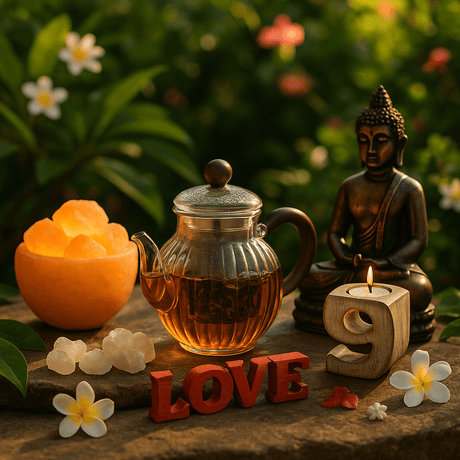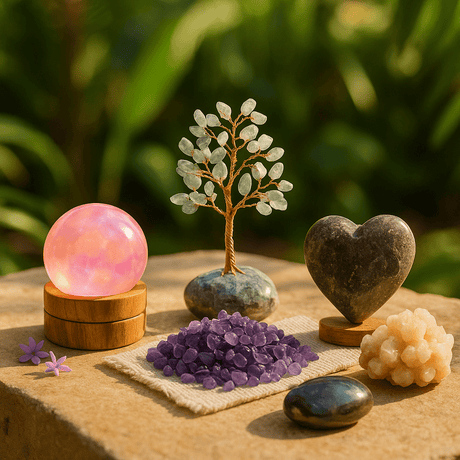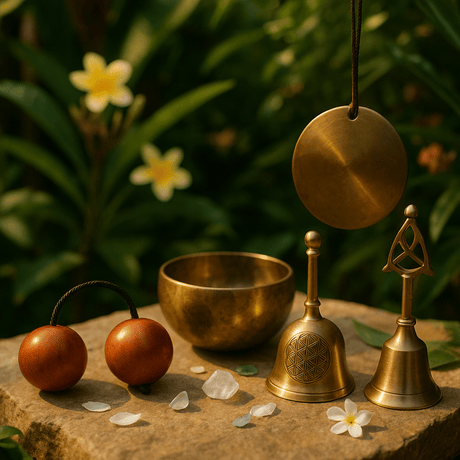Hinduismus: Eine Art zu denken und das Leben wahrzunehmen
Für mich, Hinduismus ist nicht einmal eine Religion im herkömmlichen Sinne. Es ist eine Denk- und Wahrnehmungsweise der Welt , die alle Aspekte des Lebens umfasst, von Ritualen bis hin zu alltäglichen Handlungen. Der Hinduismus lehrt uns, das Heilige im Alltäglichen zu sehen und so zu leben, dass wir der Harmonie jeden Tag näher kommen.
Aber Sanatana Dharma (सनातन धर्म) geht noch tiefer. Es ist die „ewiges Gesetz“ Sanatana Dharma ist ein „ewiger Weg“, der nicht nur dem Hinduismus, sondern auch anderen spirituellen Traditionen Indiens wie Buddhismus, Jainismus und Sikhismus zugrunde liegt. Er umfasst universelle Prinzipien, die über die Zeit hinweg unverändert bleiben. Für mich wurde Sanatana Dharma mehr als nur eine Philosophie – es wurde zu einem Kompass, der mir hilft, achtsam und mit Respekt für alle Lebewesen durchs Leben zu gehen.

Satya सत्य: Wahrheit als Weg, man selbst zu sein
Satya (Satyá) ist nicht nur Wahrhaftigkeit in Worten – es ist eine ganze Lebensphilosophie. Sie lehrt uns, ehrlich zu uns selbst und anderen zu sein, keine Vorwände zu stellen und nicht zu versuchen, jemand zu sein, der wir nicht sind. Mir wurde klar, dass Unaufrichtigkeit entsteht, weil wir unsere wahre Natur und unsere Rolle in der Welt nicht verstehen. Das verursacht inneres Unbehagen und verzerrt unsere Wahrnehmung der Realität.
„Satya lehrt dich, der zu sein, der du bist.“
Jetzt versuche ich, meine Gedanken und Gefühle offen auszudrücken, ohne Angst davor zu haben, verletzlich zu wirken. Das befreite mich von der Notwendigkeit, Rollen zu spielen, und ermöglichte es mir, im Einklang mit mir selbst zu leben.
Die Ära, in der die Wahrheit in jedem Winkel der Welt herrschte, hieß Obwohl wir jetzt in Im Kali Yuga , dem Zeitalter der Unwissenheit und der Konflikte, bleibt die Suche nach der Wahrheit ein Leitstern.

Moksha: Befreiung von Anhaftungen und dem Kreislauf der Wiedergeburt
Früher dachte ich, der Sinn des Lebens liege in Erfolg, Anerkennung und dem Erreichen äußerer Ziele . Ich glaubte, diese Erfolge würden mir wahre Befriedigung verschaffen. Doch mit der Zeit merkte ich, dass selbst die größten Erfolge mich in innerer Leere gefangen hielten. Der Frieden, den ich suchte, war immer flüchtig und floss mir wie Wasser durch die Finger. Jeder erreichte Gipfel enthüllte nur neue, steilere Hänge, und jeder Erfolg weckte neue Sehnsüchte.
Irgendwann begann ich mich zu fragen: Was, wenn die bloße Vorstellung, Frieden außerhalb von uns zu finden, eine Illusion ist? Dieser Gedanke führte mich zu einem tieferen Verständnis von Moksha (मोक्ष) . Wie mir klar wurde, ist Moksha keine Belohnung für weltliche Erfolge oder gar das Ergebnis spiritueller Praktiken. Es ist ein Zustand innerer Freiheit – einer, der entsteht, wenn das Bedürfnis, in den Augen anderer jemand zu sein oder etwas zu erreichen, verschwindet. Befreiung ist nicht das endgültige Ziel; es ist der Moment, in dem man erkennt, dass der Weg selbst immer eine Illusion war .
„Moksha ist das Erwachen aus einem Traum, in dem alle Ziele, Siege und Niederlagen nur Illusionen waren, und die Entdeckung, dass alles, was Sie suchten, immer in Ihnen war.“
Im Mittelpunkt von Moksha steht die Befreiung von Samsara (संसार) – dem endlosen Kreislauf von Geburt, Tod und Wiedergeburt. Der hinduistischen Philosophie zufolge hat jede Handlung (Karma) Konsequenzen, die die Seele an diesen Kreislauf der Reinkarnation binden. Solange wir in Wünschen, Anhaftungen und Unwissenheit gefangen bleiben, nimmt die Seele (Atman, आत्मन्) immer wieder neues Leben an und wiederholt immer wieder dieselben Muster. Moksha bietet Freiheit von dieser Wiederholung – das Ende der Wiedergeburt, nicht durch Flucht vor dem Leben, sondern durch das Überwinden der Illusionen, die Leid erzeugen .
Befreiung von Bindungen bedeutet nicht, sich von der Welt zurückzuziehen oder Verantwortungen aufzugeben. Es bedeutet, das Leben so zu akzeptieren, wie es ist , ohne den Zwang, es zu verändern oder zu kontrollieren. Es ist kein Verzicht, sondern Teilnahme ohne Anhaften . In diesem Zustand erlebt man das Leben nicht mehr durch die Linse von Erwartungen oder Ambitionen, sondern als perfekten Ausdruck des gegenwärtigen Augenblicks .
„Moksha ist nicht das Streben nach Frieden, sondern die Verwirklichung des Friedens ohne Streben.“
Dieses Verständnis von Moksha hat mein Leben verändert. Es hat mich gelehrt, dass Frieden nicht durch äußere Erfolge, sondern durch das Loslassen des endlosen Strebens gefunden werden kann. Der Kreislauf von Wünschen und Erwartungen ist nur ein Spiel des Geistes, doch Moksha erinnert mich daran, dass ich jederzeit aus diesem Spiel aussteigen kann. Jede Erfahrung, jeder Moment enthält bereits alles, was ich brauche, um mich frei zu fühlen.

Dharma-Übung: Leben in Harmonie mit Pflicht und Natur
Dharma (Dharma) ist nicht nur eine moralische Pflicht, sondern ein komplexes und vielschichtiges Konzept. Es umfasst die gesamte Weltordnung – sowohl die persönliche als auch die kosmische. Für mich wurde Dharma nicht nur zu einem Kompass für richtiges Handeln, sondern auch zu einem Weg, meinen Platz im Gesamtbild des Lebens zu verstehen.
Dharma ändert sich je nach Lebensabschnitt, Beruf und Umständen. Jeder von uns hat seine eigene Rolle und Aufgabe: Was für den einen richtig ist, muss nicht unbedingt auch für den anderen richtig sein. Das lehrt uns, Vielfalt zu respektieren und anzuerkennen, dass jeder seinen eigenen Weg geht.
„Seinem Dharma zu folgen bedeutet, im Einklang mit sich selbst und der Welt durchs Leben zu gehen.“
In der Praxis bedeutet dies, seine Pflichten mit Bereitschaft und Respekt zu erfüllen. In Beziehungen kann es beispielsweise bedeuten, sich um geliebte Menschen zu kümmern, und im Beruf kann es bedeuten, seine Verantwortung mit Integrität zu erfüllen. Auch wenn andere es nicht schätzen, bringt das Befolgen des eigenen Dharma inneren Frieden, weil man weiß, das Richtige zu tun.
Aber Dharma ist nicht nur eine Reihe von Regeln. Es erfordert auch die Fähigkeit zu erkennen, wann es notwendig ist, über konventionelle Rahmenbedingungen hinauszugehen. Das Leben ist kompliziert und unvorhersehbar, und manchmal müssen wir unsere Pflichten flexibel angehen. Weisheit liegt darin, wahre Pflichten von auferlegten Verpflichtungen zu unterscheiden.
„Nach dem Dharma zu leben bedeutet nicht, blind Regeln zu befolgen – es bedeutet, bei jeder Handlung nach Harmonie zu streben.“
Die Ausübung deines Dharma schafft gutes Karma, das dich auf dem Weg zur Befreiung unterstützt. Bewusstes Handeln, ohne Erwartung einer Belohnung, befreit uns allmählich von Anhaftungen und Egoismus. Dharma lehrt mich, das Leben nicht nur aus der Perspektive meiner Wünsche zu betrachten, sondern auch durch die Linse der Verantwortung gegenüber der Welt und anderen.

Karma-Buch: Wie meine Handlungen die Realität formen
Karma (Karma, Karma) ist das universelle Gesetz von Ursache und Wirkung. Alles, was wir tun, sagen oder denken, hinterlässt Spuren, die unweigerlich unsere Zukunft beeinflussen. Karma zeigt, dass unser jetziges Leben kein Zufall ist. Es wird von unseren Handlungen geprägt, sowohl in diesem als auch in früheren Leben. Das Verständnis von Karma hat mir gezeigt, dass ich kein Opfer der Umstände bin, sondern Schöpfer meiner eigenen Realität.
Jede Aktion, die mit Absicht (संकल्प, sankalpa) ist wie ein Samen, der schließlich sprießt und Früchte trägt. Wenn die Handlung in Freundlichkeit, Ehrlichkeit und Mitgefühl verwurzelt ist, schafft sie positives Karma (सुकर्म, sukarman) , das Harmonie und Freude bringt. Aber wenn Handlungen aus Selbstsucht, Gier oder Bosheit entstehen, erzeugen sie negatives Karma (दुष्कर्म, duṣkarman) , das Leid und Hindernisse mit sich bringt.
„Karma ist eine ständige Erinnerung daran, dass jeder Gedanke und jede Handlung wichtig ist.“
Als ich auf die Bhagavad Gita (भगवद् गीता) veränderte sich mein Verständnis von Karma und Leben grundlegend. Eine der schwierigsten Fragen für mich war die nach dem Existenz des Bösen in dieser Welt. Warum leiden Menschen? Warum existiert das Böse, wenn es einen Gott gibt? Die Bhagavad Gita half mir zu erkennen, dass das Böse keine göttliche Strafe ist, sondern eine natürliche Folge des freier Wille (स्वतंत्र इच्छा, svatantra icchā) von Gott gegeben. Durch unsere Handlungen erzeugen wir selbst Karma, das sowohl Gutes als auch Leid bringt.
„Das Böse ist nicht von Gott geschaffen – es entsteht aus unseren Entscheidungen und Handlungen.“
Die Bhagavad Gita lehrte mich auch, dass das Böse eine Chance für Wachstum und Bewusstsein bietet. Wenn wir Leid erfahren, lernen wir, zwischen Gut und Böse zu unterscheiden, und durch unsere Entscheidungen und Handlungen gestalten wir unser Schicksal. Karma ist unparteiisch: Es gibt uns zurück, was wir gesät haben, und bietet uns die Chance, die Folgen unseres Handelns zu verstehen und unseren Weg zu ändern.
Karma lehrt mich, dass die Konsequenzen meiner Handlungen, auch wenn sie nicht sofort eintreten, mit der Zeit unweigerlich sichtbar werden. Daher ist es wichtig, bewusst zu handeln, ohne sofortige Belohnungen zu erwarten. Dem Dharma folgen (धर्म) hilft mir, negatives Karma zu vermeiden und verantwortungsbewusst durchs Leben zu gehen. Dharma ist mein Kompass, der mich leitet, im Einklang mit meiner wahren Natur und Pflicht zu handeln.
„Karma erinnert uns daran, dass wir unsere Zukunft mit jedem Moment der Gegenwart erschaffen.“
Diese Philosophie hat mir geholfen, meine Einstellung gegenüber Herausforderungen zu ändern. Jetzt verstehe ich, dass selbst schwierige Situationen das Ergebnis meines Karmas sind und Lektionen enthalten, die ich lernen muss. Jede Begegnung und jede Situation ist eine Gelegenheit, neues Karma zu schaffen und harmonische Beziehungen zu mir selbst und der Welt um mich herum aufzubauen.

Ahimsa अहिंसा: Der Weg der Gewaltlosigkeit und Güte
Ahimsa (ahimsā, अहिंसा) ist nicht nur die Vermeidung körperlicher Gewalt, sondern auch das Bemühen, Schaden durch Gedanken, Worte und Taten zu verhindern. Ich erkannte, dass selbst negative Gedanken oder verletzende Worte nicht nur anderen, sondern auch mir selbst schaden.
„Wahre Stärke liegt darin, den Frieden in sich selbst und um sich herum zu bewahren, selbst angesichts von Aggression.“
Durch die Praxis von Ahimsa wurde ich bewusster, wie ich andere behandle. Dies beeinflusste meine Gewohnheiten: Ich wählte Vegetarismus als eine Möglichkeit, das Leben der Tiere zu respektieren und Konflikte zu lösen friedlich . Ahimsa hat mich gelehrt, nach Lösungen zu suchen, die Frieden statt Zwietracht bringen.
„Jedes Lebewesen ist mit uns verbunden, und Freundlichkeit gegenüber anderen kommt in gleicher Weise zu uns zurück.“
Dieses Prinzip ermutigte mich auch, auf mich selbst zu achten: Selbstverurteilung zu vermeiden und mir selbst mit Mitgefühl zu begegnen. Ahimsa beginnt im Inneren – indem man sich selbst so akzeptiert, wie man ist – und erstreckt sich erst dann auf die Beziehungen zur Welt um einen herum.

Brahman ब्रह्म und Advaita अद्वैत: Die Einheit aller Existenz
Verständnis Brahman (Brahman, ब्रह्म) war für mich ein Wendepunkt. Brahman ist die allgegenwärtige Realität das alles durchdringt. Es transzendiert Zeit und Raum und hat keine Form, doch manifestiert es sich durch alles – von Atomen bis hin zu Gottheiten wie Shiva (Shiva) Und Vishnu (विष्णु) . In jedem von uns liegt ein Fragment dieser höchsten Kraft– Atman (ātman, आत्मन्) , unsere Seele.
„Das ultimative Ziel ist es, zu erkennen, dass Atman und Brahman eins sind, und durch dieses Verständnis Befreiung vom Leiden zu erreichen.“
Als ich tiefer in die Philosophie der Advaita (Advaita, अद्वैत) begann ich zu verstehen, dass viele Unterschiede – zwischen Menschen, zwischen Gut und Böse, zwischen Leben und Tod – lediglich Illusionen (māyā, माया) Vom Geist erschaffen. Auf der tiefsten Ebene ist alles miteinander verbunden und Ausdruck desselben einheitlichen Ganzen. Die Trennung zwischen meiner Seele und der höchsten Realität existiert nur in meinem Geist.
„Wenn Sie verstehen, dass alle Unterschiede Illusionen sind, folgen wahrer Frieden und Freiheit.“
Diese Erkenntnis veränderte meine Wahrnehmung der Welt und befreite mich von engen Identitäten wie Rasse, Religion oder Kultur. Ich hörte auf, Menschen durch diese Linsen zu sehen, und erkannte, dass jeder Mensch Teil desselben Brahman ist. Jetzt strebe ich danach, das zu sehen Seele in jedem Menschen, und nicht in den Etiketten oder Rollen, die er verkörpert.
„Wenn man in jedem Menschen ein Fragment von Brahman sieht, fällt es leichter, ihn so zu akzeptieren, wie er ist.“
Dieses Bewusstsein hat mir inneren Frieden geschenkt und mich gelehrt, der Welt mit Toleranz und Mitgefühl zu begegnen. Unter den oberflächlichen Unterschieden sind wir alle Manifestationen desselben Ganzen.
Respekt für die Vielfalt und die vielen Wege zum Göttlichen
Eine der inspirierendsten Ideen für mich ist die Erkenntnis, dass in der Hinduistische Denkweise , gibt es keinen einzigen, richtigen Weg zum Göttlichen. Diese Philosophie umfasst Diversität in allen Aspekten – Glauben, Rituale, spirituelle Praktiken und Wege zur Erleuchtung. Jeder Mensch ist einzigartig, und seine Reise zur Wahrheit lässt sich nicht durch starre Regeln oder Dogmen einschränken.
„Der spirituelle Weg ist keine Ansammlung von Lehren, sondern eine persönliche Reise, bei der jeder Mensch seinen eigenen Rhythmus und seine eigene Richtung wählt.“
Es gibt verschiedene Yogas (Yogas) die Menschen helfen, spirituelle Erkenntnis zu erlangen:
- Bhakti Yoga (भक्ति योग) – der Weg der Liebe und Hingabe für diejenigen, die sich durch Anbetung und tiefe emotionale Verbundenheit mit dem Göttlichen verbinden.
- Jnana Yoga (ज्ञान योग) – der Weg des Wissens, der Suchende durch philosophische Kontemplation und Selbsterforschung zur Wahrheit führt.
- Karma Yoga (कर्म योग) – der Weg des selbstlosen Handelns, auf dem man durch den Dienst an anderen Befreiung erlangt.
- Raja Yoga (राज योग) – der Weg der Meditation und Selbstdisziplin, der die Tür zu innerem Frieden und Stille öffnet.
Diese verschiedenen Wege zeigen, dass jeder Einzelne den Ansatz wählen kann, der ihm am besten passt. Sie lehren, dass Aufklärung kann durch verschiedene Formen des Strebens erreicht werden – sei es durch Handeln, Liebe, Wissen oder Meditation.
„Die Wahrheit ist nicht das Monopol eines Weges. Alle Wege führen zum selben Ziel – der Erkenntnis der Einheit mit dem Göttlichen.“
Was mich am meisten inspiriert, ist, wie Polytheismus und Monotheismus koexistieren harmonisch innerhalb dieser Philosophie. Manche sehen das Göttliche in vielen Göttern, die jeweils unterschiedliche Aspekte der höchsten Realität repräsentieren, während andere es vorziehen, eine höchste Kraft anzubeten. Beide verstehen, dass hinter all diesen Formen dasselbe steckt Brahman (Brahma, ब्रह्म) .
„Jede Gottheit ist nur ein Fenster in dieselbe unendliche Realität.“
Diese Offenheit und der Mangel an Dogmatismus haben mir die Freiheit gegeben, Spiritualität als Reise der Akzeptanz und Erkundung anstatt sich an strenge Regeln zu halten. Im Sanatana Dharma, Vielfalt wird nicht nur toleriert – sie wird gefeiert . Diese Weltanschauung lehrt uns, die Überzeugungen anderer zu respektieren und den Wert jeder Praxis anzuerkennen, auch wenn sie sich von unserer eigenen unterscheidet.
„Jeder Weg hat seine Bedeutung und alle führen zum Göttlichen. Entscheidend ist nicht, wie du gehst, sondern dass dein Herz für die Wahrheit offen ist.“
Dieses Verständnis hat mich von der Notwendigkeit befreit, externe Erwartungen zu erfüllen, und mich gelehrt, die Wege anderer zu respektieren. Spiritualität ist kein Wettbewerb, sondern ein Raum der Entdeckung, in dem jeder seinen eigenen Weg finden und ihn in seinem eigenen Tempo gehen kann.
Zeit als zyklisch und ewig
In Sanatana Dharma , Zeit wird wahrgenommen als Zyklus (Yuga, Yuga) kein linearer Prozess. Alles im Leben durchläuft wiederkehrende Phasen: Geburt, Wachstum, Niedergang und Erneuerung. So wie auf die Nacht der Tag folgt und auf den Winter der Frühling, folgen auch die Ereignisse unseres Lebens einem zyklischen Muster.
„Nichts währt ewig – weder Freude noch Leid. Alles kommt und geht, nur um wiederzukommen.“
Diese Perspektive auf die Zeit gibt mir Geduld und Belastbarkeit . Prüfungen und Härten, wie die Kali Yuga (कलियुग) – das Zeitalter der Dunkelheit – wird unweigerlich weichen Satya Yuga (सत्ययुग) – das Zeitalter der Wahrheit und Harmonie. Das Verständnis der zyklischen Natur der Existenz hilft mir, schwierige Momente zu akzeptieren, da ich weiß, dass sie vorübergehend sind.
„Wenn es heute Nacht dunkel ist, wird es morgen sicher Licht geben.“
Ein wesentlicher Teil dieser Weltanschauung ist die langfristige Perspektive . Das Leben endet nicht mit einer Inkarnation – jede Handlung hinterlässt Spuren und beeinflusst nicht nur das gegenwärtige Leben, sondern auch die kommenden. Reinkarnation (पुनर्जन्म, punarjanma) Und Samsara (Samsara) stellen die Reise der Seele durch viele Geburten und Tode dar, bei der sie kontinuierlich lernt und sich weiterentwickelt.
„Das Ziel ist nicht kurzfristiger Erfolg, sondern kontinuierliches spirituelles Wachstum, das über ein einzelnes Leben hinausgeht.“
Die Zeit als zyklischen Prozess zu sehen, lehrt mich Ich bin nicht an unmittelbaren Ergebnissen orientiert . Das befreit mich von Ängsten und ermöglicht es mir, die Reise selbst zu schätzen. Es zählt nicht, wie viel ich in einem kurzen Moment erreiche, sondern dass jede Handlung und jede Anstrengung zu meiner spirituellen Entwicklung beiträgt.
„Wahre Weisheit liegt darin, über den gegenwärtigen Moment hinauszublicken und zu verstehen, dass jeder Moment in den unendlichen Faden der Zeit eingewoben ist.“
Respekt vor Natur und Umwelt
Die Natur ist eine heilige Manifestation des Göttlichen . Alles um uns herum – Flüsse, Berge, Bäume, Tiere und sogar die Elemente – ist erfüllt von Brahman (ब्राह्मण) und durch eine gemeinsame Energie mit uns verbunden. Im Sanatana Dharma werden die Menschen nicht als Herrscher der Natur betrachtet, sondern als ein untrennbarer Teil davon, mit dem sie in Harmonie leben müssen.
„Die Natur ist nicht nur die Kulisse unseres Lebens, sondern das lebendige Gewebe des Universums, in das unsere Seelen eingewoben sind.“
Diese Überzeugungen spiegeln sich wider in tägliche Traditionen . Natürliche Elemente werden als heilig verehrt, weil sie verschiedene Aspekte des Göttlichen verkörpern. Die Ganga-Fluss (गंगा) wird als lebende Göttin verehrt, die reinigt und segnet. Das Baden in ihrem Wasser ist nicht nur ein Ritual, sondern auch ein Ausdruck der Dankbarkeit für ihre Großzügigkeit und lebensspendende Kraft.
„Das Wasser des Ganges ist nicht nur ein Strom, sondern ein Hauch von Ewigkeit.“
Bäume nehmen auch in der spirituellen Praxis einen besonderen Platz ein. Tulsi (तुलसी) gilt als Inkarnation der Göttin Lakshmi und bringt dem Haushalt Wohlstand und Schutz. Bilva (बिल्व) , mit Shiva assoziiert, wird oft in Anbetungsritualen verwendet. Peepal (Peepal) Und Banyan (वट) Bäume symbolisieren Weisheit und Unsterblichkeit, und ihre Äste dienen als Orte der Meditation. Menschen binden heilige Fäden um ihre Stämme und beten um Wohlergehen und Schutz.
„Jeder Baum ist ein stiller Wächter, der denen, die ihn suchen, Weisheit und Schutz bietet.“
Diese Ehrfurcht vor der Natur lehrt uns, dass Ein Leben im Einklang mit der Umwelt ist nicht nur eine Verantwortung, sondern eine spirituelle Praxis . Indem wir die Natur respektieren, ehren wir die göttliche Präsenz in ihr und erkennen unsere Rolle bei der Erhaltung des Gleichgewichts des Lebens an.
Respekt vor Älteren
Respekt vor Älteren ist nicht nur Höflichkeit, sondern eine tiefgründige spirituelle Praxis. Im Hinduismus werden Eltern, Lehrer und ältere Menschen als Sie sind Wissensführer und Hüter der Tradition und geben ihr Wissen von Generation zu Generation weiter. Sie helfen uns nicht nur, die Welt zu verstehen, sondern auch, unseren eigenen Platz darin zu finden.
„Der Respekt vor den Älteren ist eine Anerkennung dafür, dass unser Leben eng mit der Geschichte und Tradition verwoben ist.“
Als Zeichen der Ehrerbietung ist es üblich, die Füße der Ältesten berühren oder Ich verneige mich vor ihnen und bitte um ihren Segen. Mit der Zeit wurde mir klar, dass diese Geste mehr ist als nur eine Formalität oder das Festhalten an einer Tradition. Für mich ist sie zu einem Symbol der Dankbarkeit für ihre Erfahrungen und Lebenslektionen. Es erinnert mich daran, dass ihre Weisheit eine unschätzbare Ressource ist, die mich auf meinem Weg unterstützt und mir hilft, zu wachsen.
Der Respekt vor Älteren lehrt auch Demut und Dankbarkeit. Es erinnert uns daran, dass jeder von uns Teil von etwas Größerem ist, und unsere Pflicht ist es, das Traditionen und bewahren die Kultur für zukünftige Generationen. Wir leben nicht nur für uns selbst; wir geben die Fackel weiter und sorgen dafür, dass die Verbindung zwischen den Generationen ungebrochen bleibt.
„Indem wir die Weisheit der Vergangenheit annehmen, werden wir zu einem Glied in der Kette, die die Generationen miteinander verbindet.“
Rituale und Symbole: Spirituelles Bewusstsein im Alltag
Rituale und Traditionen verwandeln das Leben in ein sinnvollen Zyklus , in dem jede Phase und jedes Ereignis bedeutsam wird. Sie lehren mich in Schlüsselmomenten innehalten und sie bewusst zu erleben, ohne sich in der Hektik des Alltags zu verlieren. Diese Praktiken schaffen eine Struktur, durch die selbst alltägliche Handlungen Tiefe gewinnen und mich mit etwas Größerem verbinden als nur dem Fluss gewöhnlicher Tage.
„Rituale sind eine Möglichkeit, das Heilige in das Gewebe des täglichen Lebens einzuweben.“
Jedes Ritual – sei es ein morgendlicher Gruß an die Sonne oder komplexe Übergangsriten – hilft mir Lausche dem Fluss der Zeit , spüre den Moment und spüre die tiefere Realität dahinter. Anstatt durch das Leben zu treiben, sehe ich es als eine kontinuierliche und harmonischer Kreislauf , in dem jeder Moment Aufmerksamkeit verdient.
Symbole spielen in diesen Praktiken eine entscheidende Rolle. Sie dienen als spirituelle Sprache , die vermittelt, was Worte nicht ausdrücken können. Symbole – ob Mandalas, heilige Muster oder Bilder von Gottheiten – ermöglichen es mir, Verbinde dich mit dem Unsichtbaren . Ihre Bedeutung entfaltet sich allmählich durch Kontemplation und inneres Verständnis.
„Symbole erinnern uns daran, dass hinter der sichtbaren Welt eine tiefere Realität liegt.“
Durch Rituale und Symbole habe ich gelernt, Leben Sie bewusster und finden Sie Bedeutung in Dingen, die einst banal erschienen. Jede Geste, jede Handlung wird Teil eines einheitliche spirituelle Reise , die das Leben nicht nur mit Schönheit, sondern auch mit Sinn erfüllt.
Fazit: Zwischen Streben und Akzeptanz
Das Eintauchen in den Hinduismus hat meine Perspektive wirklich verändert, aber ich kann nicht behaupten, dass es mich zu einem aufgeklärten und ruhigen Menschen gemacht hat. Jeder Tag bleibt ein Kampf – sowohl mit der Welt als auch mit mir selbst. Die Philosophie bietet Orientierung, doch die Realität erweist sich wie immer als komplizierter. Trotz des Bewusstseins dieser weisen Prinzipien mache ich immer noch Fehler, empfinde Wut und hänge an Dingen und Menschen, die ich längst hätte loslassen sollen.
Gefolgt Dharma Das Loslassen von Bindungen ist in der Praxis nicht einfach. Manchmal sind meine Handlungen nicht von edlen Absichten getrieben, sondern von Ängsten und alten Gewohnheiten. Es gibt Tage, an denen alles schief zu laufen scheint, und Gedanken an Karma oder Gewaltlosigkeit bieten wenig Trost. Doch der Hinduismus hat nie ein perfektes Leben ohne Leiden versprochen – er legt lediglich eine andere Sichtweise nahe.
Ich schätze die Idee, dass Perfektion ist unerreichbar , und das ist okay. Auch wenn ich es nicht immer schaffe, meinen Idealen gerecht zu werden, ist es wichtig, die Orientierung nicht zu verlieren. Vielleicht geht es beim spirituellen Wachstum nicht darum, immer ruhig und rechtschaffen zu sein, sondern darum, Verletzlichkeit und Unvollkommenheit zu akzeptieren und trotzdem weiterzumachen. Das fühlt sich für mich ehrlich an.
Jetzt versuche ich, mir nicht die Schuld für meine Schwächen zu geben, sondern sie als Teil meiner Reise zu sehen. Der Hinduismus lehrt mich, dass das Ziel nicht darin besteht, perfekt zu werden, sondern einfach weiterzumachen – Tag für Tag. Das bringt ein seltsames Gefühl der Erleichterung: zu wissen, dass ich nicht jemand anderes oder perfekt sein muss. im Augenblick. Es reicht, in diesem Moment der zu sein, der ich bin, und mich einfach immer ein Stück weiter der Person anzunähern, die ich werden möchte.
„Sie haben das Recht zu handeln, aber nicht auf die Früchte Ihrer Handlungen. Denken Sie nicht, dass Sie die Ursache des Ergebnisses sind, und suchen Sie keine Zuflucht in Untätigkeit.“
— Bhagavad Gita, 2.47


